This week’s Weekly includes my review of Blazo Kovacevic‘s exhibit “Maps and …” at Hurong Lou Gallery. And in the paper’s holiday guide section there’s my round-up of shows for a photo- and video-rich holiday season. Here are links to the Kovacevic review on the art page and to the holiday roundup. And below is the copy for both with some extra pictures.
Tear It Up
Blazo Kovacevic‘s exhibit at Hurong Lou Gallery grabs you with its graphic crispness, beautiful appropriated imagery and hint of threat. Beauty and threat? Consider the whole experience of the show a personal Rorschach test. (image is affixed to the plexiglas top of a small round table.)
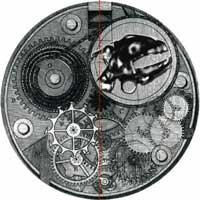
Kovacevic uses appropriated images-ancient maps, architectural drawings and repeat patterns of flowers and fleurs-de-lis. He prints, draws or paints the imagery on his canvas, vinyl or mesh supports, and then superimposes ominous and militaristic images of metal tools. With their open jaws, pincers, sawtooth edges, wings and bayonet-like protrusions, the tools evoke instruments of torture or a swarm of killer robot insects. They’re bigger than life, and they cast long shadows over the appropriated imagery.
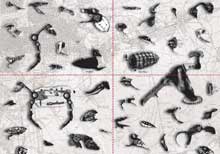
“Mimi, Bertha and the rest of the gang,” (image above) are what the Montenegro-born artist calls the tools, displayed taxonomy-style in a large mixed-media piece by that name.
Their presence is threatening, but here’s the question: Are the tools enemies at the gate or sentinels guarding the precious beauty? Either way, they evoke conflict.
Here’s another test: The gallery floor is untidy with crumpled newspaper, Styrofoam chips and a random plastic utility bucket. What gives? Kovacevic, whose work also deals with the value and commodification of art, left the byproducts of the show’s installation as a reminder that art’s backstage is messy. “It’s the aesthetics of junk,” the artist says.
“It gives you details you can use on the origin of the work. I also like it because you question, ‘Are we done?’ And I don’t believe we can be.” Artists are never really done with their art. They just let it go.
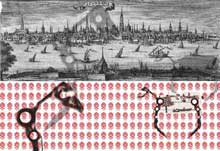
Test three: Many works have perforation lines dividing them vertically or horizontally, like longitude or latitude markers. A viewer can decide they’d like a piece of one and not the whole, and the artist will cut or tear along the perforated line. Sundering a piece of art is transgressive. But Kovacevic has played capitalist god here, enabling the viewer’s transgression.
In some cases the works are worth dividing. Duel, a large work with a medieval walled town in the background and two hulking tools in the foreground, can be split into two asymmetrical pieces (with asymmetrical pricing). The two pieces are stronger separated. Like those “friends forever” heart necklaces, two art lovers could split a Kovacevic work and create an instant bond between them.
Maybe dividing a whole, whether it’s art or a country, can be something done amicably-to create friendship, not war. That’s my thought after seeing this show.
Kovacevic, who now lives in Savannah, Ga., is a computer whiz, having founded the International Digital Art Festival. While in Philadelphia he worked with gallerist Hurong Lou as an art director.
“Blazo Kovacevic: Maps and … “
Through Dec. Hurong Lou Gallery, 320 Race St. 215.238.8860.
Screen Glints
Mavericks and a New Color Master
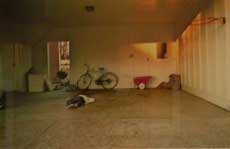
When it comes to photography, four exhibits give a lot of visual pleasure and would make an invigorating photo-walking tour both between the venues and once you’re inside. “Mavericks of Color” at the Philadephia Museum of Art, a group show focused on the roots of color photography in the 1960s and ’70s, is a look back at work by American pioneers like William Christenberry, William Eggleston and Joel Meyerowitz. (We’ve told you about Mavericks here and here.)
(image above is photo by Eggleston)

Vik Muniz‘s photographs at Pennsylvania Academy of the Fine Arts‘ Morris Gallery-large prints of his dazzling drawings in oddball materials like chocolate syrup, dust and thread-will bring your experience of the medium up to date. Muniz’s works are so far from the snapshot aesthetic of the mavericks, they almost constitute a new genre: conceptual trompe l’oeil. (Here’s my post on Muniz’s family workshop at PAFA, which, I realize, I want to flesh out a bit so hang on for that.)
(image is Muniz at his family workshop at PAFA)
Figures old and new
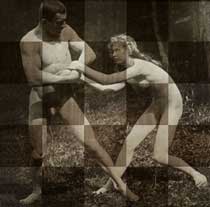
Figure studies are a traditional photography subject, especially in Philadelphia, with its ties to Thomas Eakins and Eadweard Muybridge. Two shows by local artists continue the tradition: Paul Cava at Gallery 339 and Susan Fenton at Schmidt-Dean. Cava’s multilayered imagery, some using found photos and digital technology, is surreal and poetic. (image above is Cava’s “Eden.”)
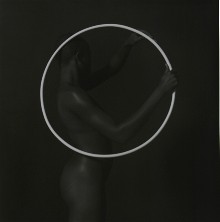
Fenton’s stylized studies of her African model Fatima suggest an almost Victorian symbolism-the nude model posing, partly hidden by objects like a parasol, a clay jar, a large ball or a veil. (Fenton Fatima image)
These sensuous almost full-body photos are a departure for the artist from her previous hand-painted photos of a model’s head and neck. The new pictures raise timely questions about the definition of beauty and about the colonial gaze, something that always bears study. (Here’s Libby’s Q&A with Fenton)
Harvey’s Split-Screen Mirror and Graham’s Sisyphus
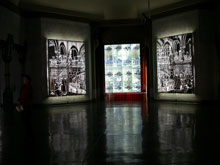
As far as video goes, Ellen Harvey‘s multimedia work at PAFA and Rodney Graham‘s film and video retrospective at the Institute of Contemporary Art are exhibitions with theoretical and conceptual underpinnings. The works have great beauty, and a satisfying theatricality as well. Harvey’s installation, in PAFA’s second-floor rotunda, creates a darkened space with large multipanel mirrors, a video projection and two side video pieces showing the artist’s hand making a pencil sketch of a museum building. The work adds up to a PAFA chapel devoted to contemplation of the building and to the idea of the museum as an institution. It’s a slow piece and elegant, and I wished there had been a bench to sit down on. (Here’s part one and part two of Libby’s report on Shamim Momim‘s lecture at PAFA on Harvey’s art.)
(image is the Harvey installation at PAFA which creates a dark grotto in what is usually a luminous rotunda.)
For me the best part was the two video drawings that slowly came to life with pencil lines laid down and corrected and put down anew-seemingly in real time. The slow, torturous process of work to create a finished drawing made me think about how museums are slow in a fast world–and how precious that is.
Rodney Graham‘s works at the ICA are eloquent, philosophical and trippy. The Canadian artist zeroes in on life’s Sisyphean nature, where pushing the rock up the hill is followed inevitably by its fall back down. Graham tells this one story again and again in works that are mostly wordless. (Here’s Libby’s great post on the show.)
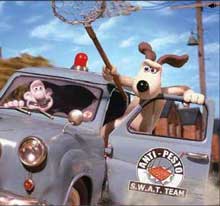
And while the pieces are in gorgeous color and set in beautiful locales (a tropical island, the North American West, a cobblestone street in what looks like Europe), they have the feel of early silent films by Charlie Chaplin or Buster Keaton: sad-sack slapstick. In fact, Hollywood is never far from the surface in works that are costume genre pieces (the rambling cowboy, the Edwardian comedy of manners, the South Seas adventure story, the Keystone Kop/vaudeville routine). (they’re not too far from the great Wallace and Gromit whose exploits always include pithy thoughts about the ridiculousness of life.)

The artist is a one-man show performing in each piece, often in multiple roles. The camera can’t get enough of him. But Graham’s focus on himself is an anti-star turn that mocks instead of heroicizes. There’s less action and humor here than in the new Wallace & Gromit movie. But you could argue there’s as much beauty and delight in the details. (Check out the aardman website for lots of fun interactive animation… and many links to W&G and other Nick Park characters)
(image is from Graham’s “Vexation Island.”)
Graham’s exhibition, which includes some photo pieces and a “little schoolhouse” slide show of a trip the artist took to Kurt Cobain’s Washington state hometown, is one of the best hours I spent looking at art this fall.
Party On
Along with the photography and video bonanza this season, there’s also a more traditional-media big-name group exhibit at the Fabric Workshop and Museum opening Dec. 2. It brings work by 15 artists and a couple of design teams together for a show that’s about birds and bees and other biologically or emotionally destined swarmers.
The show’s underpinnings are in science or pseudoscience, in which labels like “swarm logic” are applied to behavior that’s predictably unpredictable. My prediction is that the show, whose participants include international art stars like Julie Mehretu, Sarah Sze, Fred Tomaselli, Shahzia Sikander and Paul Pfeiffer, will be a satisfying romp no matter how you define group behavior and its wisdom (or lack thereof).
———————
“Ellen Harvey: Mirror”
Through Jan. 8. Pennsylvania Academy of the Fine Arts, Morris Gallery, Broad and Cherry sts. 215.972.7600.
“Mavericks of Color”
Through Nov. 27. Philadelphia Museum of Art, 26th St. and the Pkwy. 215 763 8100.
“Paul Cava: Children of Adam”
Through Nov. 27. Gallery 339, 339 S. 21st St. 215.731.1530.
“Rodney Graham: A Little Thought”
Through Dec. 23. Institute of Contemporary Art, 118 S. 36th St. 215.898.5911.
“Susan Fenton: Fatima”
Through Nov. 26. Schmidt-Dean Gallery, 1710 Sansom St. 215.569.9433.
“Swarm”
Dec. 3-March 18. Fabric Workshop and Museum, 1315 Cherry St. 215.568.1111. Opening reception and holiday party, Friday, Dec. 2. 5-9 pm.
“Vik Muniz”
Through Nov. 20. Pennsylvania Academy of the Fine Arts, Morris Gallery, Broad and Cherry sts. 215.972.7600.









